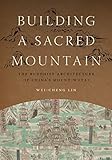Building a sacred mountain : the Buddhist architecture of China's Mount Wutai / Wei-Cheng Lin.
Material type: TextSeries: Art history publication initiative | China Program bookPublisher: Seattle, Washington : University of Washington Press, [2014]Description: 1 online resource (xi, 321 pages)Content type:
TextSeries: Art history publication initiative | China Program bookPublisher: Seattle, Washington : University of Washington Press, [2014]Description: 1 online resource (xi, 321 pages)Content type: - text
- computer
- online resource
- 9780295805351
- 0295805358
- Wutai Mountains (China) -- History
- Buddhist architecture -- China -- Wutai Mountains
- Buddhist monasteries -- China -- Wutai Mountains
- Buddhism and culture -- China -- Wutai Mountains
- Wutai Shan (Chine) -- Histoire
- Architecture bouddhique -- Chine -- Wutai Shan
- Monastères bouddhiques -- Chine -- Wutai Shan
- Bouddhisme et civilisation -- Chine -- Wutai Shan
- ART / Asian
- HISTORY / Asia / China
- RELIGION / Buddhism / History
- Buddhism and culture
- Buddhist architecture
- Buddhist monasteries
- China -- Wutai Mountains
- Architektur
- Höhlentempel
- Buddhismus
- Wutai Shan
- China
- Buddhistisk arkitektur
- 951/.17 23
- DS793.W8222
- ART019000 | HIS008000 | REL007010
| Item type | Home library | Collection | Call number | Materials specified | Status | Date due | Barcode | |
|---|---|---|---|---|---|---|---|---|
 Electronic-Books
Electronic-Books
|
OPJGU Sonepat- Campus | E-Books EBSCO | Available |
"By the tenth century CE, Mount Wutai had become a major pilgrimage site within the emerging culture of a distinctively Chinese Buddhism. Famous as the abode of the bodhisattva Majusri (known for his habit of riding around the mountain on a lion), the site in northeastern China's Shanxi Province was transformed from a wild area, long believed by Daoists to be sacred, into an elaborate complex of Buddhist monasteries. In Building a Sacred Mountain, Wei-Cheng Lin traces the confluence of factors that produced this transformation and argues that monastic architecture, more than texts, icons, relics, or pilgrimages, was the key to Mount Wutai's emergence as a sacred site. Departing from traditional architectural scholarship, Lin's interdisciplinary approach goes beyond the analysis of forms and structures to show how the built environment can work in tandem with practices and discourses to provide a space for encountering the divine.Wei-Cheng Lin is assistant professor of Chinese art history at the University of North Carolina at Chapel Hill. "A well-researched, serious, significant book on fascinating subjects with profound impact on Chinese civilization." - Nancy Steinhardt, University of Pennsylvania"-- Provided by publisher.
"In this interdisciplinary investigation of the architecture of the sacred, Lin traces the confluence of factors that, over a period of several centuries, transformed Mount Wutai in northeastern China's Shanxi Province--a wild area that had long been believed by Daoists to be sacred--into an elaborate complex of Buddhist monasteries. This case study illustrates key steps in the transformation of Buddhism, as the religion's practices, texts, and visual culture evolved from its Indian roots and was adapted to the social milieu and geography of China. By the tenth century C.E., Mount Wutai had become a major Buddhist pilgrimage site, as it was believed to be the abode of the bodhisattva Mañjuśrī (who rode about the mountain on his hallmark lion), and an entire cave (Mogao Cave 61) depicting the wonders of Mount Wutai was constructed in the famous complex of Buddhist caves near Dunhuang, along the Silk Road. Through analysis of texts, visual art, and architecture, Lin shows how the built environment can provide a space for encountering the divine"-- Provided by publisher.
Includes bibliographical references (pages 275-308) and index.
Locating the Sacred Presence in Monastery, Monasticism, and Monastic Architecture -- Entering the Mountains, Localizing the Sacred Presence -- The Sacred Presence from Site to Site -- Mount Wutai as Virtual Monastery -- Reconfiguring the Center -- Narrative, Visualization, and Transposition of Mount Wutai -- Conclusion: Revisiting Foguang Monastery -- Appendix 1. Three Versions of the Creation Legend of the "True-Presence" (Zhenrong) Icon -- Appendix 2. Transcription and Translation of the Inscription on the Octagonal Stone Lantern -- Appendix 3. Chinese Texts.
Description based on print version record and CIP data provided by publisher; resource not viewed.
eBooks on EBSCOhost EBSCO eBook Subscription Academic Collection - Worldwide
There are no comments on this title.

